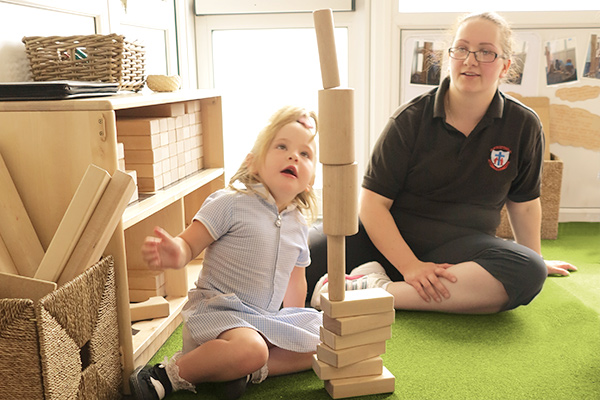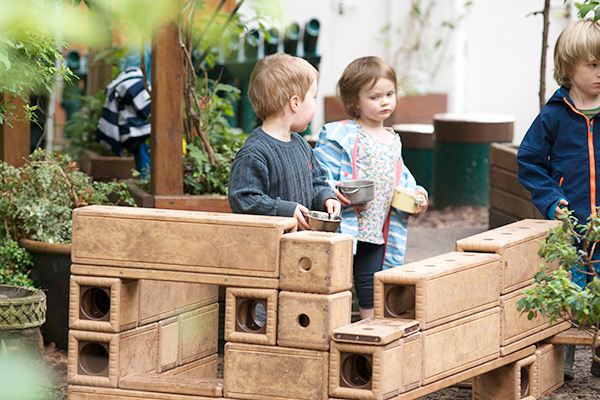Play it forward
Toward the basics and beyond
| July 2018We often hear the phrase “back to basics”. Perhaps we need to reframe that conversation. In the early years field we must think about “TOWARDS the basics and BEYOND!”
The kinds of traditional play that children have done naturally for generations is still at the foundation of the work that we do, and need to do, with children. We have the wisdom of the sages through the ages, but we also have the wisdom of the children right here, right now.
When we stand back and watch children play, instead of constantly directing them, we can appreciate what they are actually learning and doing. Sometimes we are so caught up in our roles as facilitators, guides, or teachers, we lose sight of what is truly happening.

A young child at the water table will pour and pour, over and over again. She is discovering exactly how the water goes through a certain shaped container. She is a natural scientist changing the variables to understand the different reactions. Another is sifting the sand in different ways. He watches carefully as the grains of sand cascade onto the table, down to the ground, or on his belly! The scientific method was invented, not by a scientist in a lab, but by preschoolers on the playground.
A youngster stacks the blocks, repeatedly trying to figure out how they can stand up, or maybe, better yet, how they fall down. As adults we may admire the buildings that sturdily stand tall. However, the little engineers love to watch them crash down. “Wow! That was fun!” says the preschooler. “Aha,” the physics professor says, “This is an example of cause and effect.” Hopefully the early years practitioners are saying that as well, instead of thinking, “Oh my, that was a big, noisy crash and a big mess to clean up.”

Like Edison testing his light bulbs, it takes practice, perseverance, and tenacity to make new discoveries about how things work in this world. Sometimes it is more fun to find out how they do not work. Those skills are hard to teach, yet when we offer children opportunities to practice them, they are indeed dedicated, miniature engineers.
We see how devoted young children are to outcomes. A young wobbler or toddler will fall down, get up, and try, try again. She wants to master that skill to get across the room to grab that enticing toy. She is highly motivated. We see how determined she is. That is the joy of learning that we need to tap into as much as possible.
Sometimes, as educators, we interfere with that motivation and persistence. We can be the architects of activities; we can also be partners in play. We provide those opportunities with the best materials, and guide them with some questions. Then we must give children the time they need to explore and wonder. Sometimes we need to give ourselves the time to explore and wonder right alongside them. How can we facilitate play if we have forgotten how to do that ourselves?
Too often people are ringing bells and making children move on to the next “enriched activity”. We need to sometimes simply step back and be the observer after we have helped provide the tools and the environment.
Piaget said that children construct their own knowledge. They need time to do that construction both with their bodies and their brains. Vygotsky’s ideas of supporting and scaffolding learning goes so well with construction. No wonder our programs often sound like construction sites!
As adults we are often in a hurry. Sometimes we pass on that frenetic pace to the children. That may interfere in how they play, how they learn. We need to slow down to see how children are learning, playing, and thinking.

Time stands still when play happens. The world disappears and we are immersed in the moment. A child pours the water watching the sunlight glitter in the droplets. The sand shimmers as the grains fall through a sieve. The smooth wooden block is soothing to the touch.
“Teacher, LOOK!” they say to us. It is good advice. We need to stop, look, and listen as they do. Let’s watch and appreciate their deep engagement, singular focus, and creative innovation. We often discuss modelling behaviour for children. What about flipping that paradigm? We need to see play as they do. Perhaps they are the experts here from whom we can learn. Their gift to us is that they show us how to live in the wonder of the moment.
Play is a seemingly simple concept, a basic right of childhood. Yet, it is also complex and, in recent times, controversial. The conversation is not about play versus education. Play is still at the core. Play is at the heart of all that we do with young children. It weaves and threads all the skills and abilities together into a brilliant tapestry.
With the children we can move from “basics to the beyond”– a bridge from the past with a leap to a rich, engaging future!






